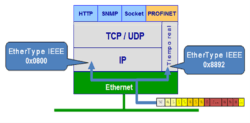PROFINET network installations typically operate in demanding industrial environments. PROFINET exchanges IO data with the appropriate speed and determinism required by manufacturing plants.
To ensure suitable performance, PROFINET delivers data through the following communication channels:
- TCP/IP or UDP/IP for non-time-critical tasks,
- PROFINET Real-Time (RT) for time-critical cyclic data exchange
- PROFINET Isochronous Real-Time (IRT) for time-critical cyclic data exchange
- PROFINET over TSN (not yet available in products)
We will discuss determinism in PROFINET projects employing PROFINET RT and IRT. All PROFINET products utilize PROFINET RT, but not all support PROFINET IRT, as it is considered an optional feature.
PROFINET RT and Determinism
PROFINET RT meets nearly all of the industry’s timing requirements, and almost all PROFINET frames are sent via this method.
The overall performance of PROFINET installations will depend on network design, but generally, cycle times of 512 ms down to 250 µs and 100 µs of jitter can be achieved with PROFINET RT. PROFINET RT messages skip TCP/IP layers, improving communication speed and determinism significantly.
Learn more about how PROFINET RT works and implementation details with this article: A Guide to PROFINET RT.
PROFINET IRT and Determinism
Unavoidably, under high network traffic, some time-critical messages can gain jitter. PROFINET IRT eliminates these variable delays by enhancing the rules employed to switch Ethernet traffic and creating special rules for PROFINET traffic, such as bandwidth reservation, synchronization, scheduling, fragmentation, fast-forwarding, and dynamic packing.
PROFINET IRT fulfills all synchronization requirements and allows deterministic communication with cycle times down to 31.25 µs and 1 µs of jitter. PROFINET IRT is only used in the most demanding applications, such as packing machines, printing presses, and wood-processing machines.
If you are interested in employing PROFINET IRT, start reading this article: PROFINET Isochronous Real-Time.
TLDR: PROFINET RT fulfills the requirements of nearly all industrial automation timing requirements. Most PROFINET networks can solely rely on PROFINET RT for all cyclic data exchange. PROFINET IRT is a step further to meet the needs of high-performance applications.
For a more in-depth comparison between PROFINET RT and IRT, make sure to read this article: PROFINET RT vs. IRT.

